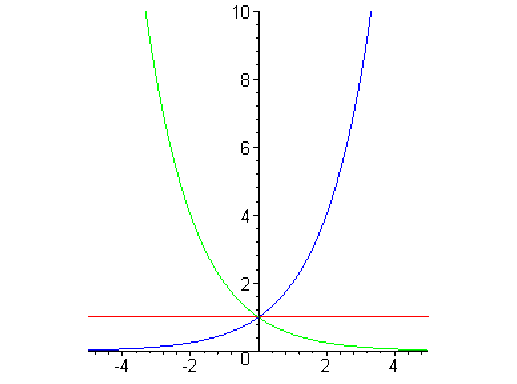Fonction exponentielle de base a (a > 0)
Définition
Définition : 3
Soit \(a\) un nombre réel strictement positif, la fonction \(\sigma : \mathbb R \rightarrow \mathbb R\) définie par \(\sigma(x) = a^x\) s'appelle la fonction exponentielle de base \(a\).
Dans le cas \(a = e\)(caractérisé par \(\ln e = 1)\) on retrouve la fonction exponentielle déjà étudiée. Ceci justifie la notation \(e^x\)à la place de \(\exp x.\)
Dans le cas général \(\forall x \in \mathbb R~~\sigma(x) = e^{x\ln a}\)donc \(\ln \sigma(x) = x\ln a,\) \(\sigma\) est dérivable comme composée de fonctions dérivables et en utilisant la règle de dérivation des fonctions composées il vient \(\forall x \in \mathbb R~~\sigma'(x) = (\ln a)e^{x\ln a} = (\ln a)a^x\) d'où
\(\boxed{\forall a > 0~~\forall x \in \mathbb R~~\ln a^x = x\ln a,~~(a^x)'=(\ln a)a^x}\)
Variations et représentation graphique
En utilisant la valeur de la dérivée et les limites des fonctions logarithme et exponentielle, il vient
\(\boxed{0 < a < 1~~\textrm{La fonction exponentielle de base a est décroissante}}\\ \boxed{\displaystyle \lim_{x \rightarrow -\infty}a^x = +\infty}\boxed{\displaystyle \lim_{x \rightarrow +\infty}a^x = 0}\\ \\ \boxed{a > 1~~\textrm{La fonction exponentielle de base a est croissante}}\\ \boxed{\displaystyle \lim_{x \rightarrow -\infty}a^x = 0}\boxed{\displaystyle \lim_{x \rightarrow +\infty}a^x = +\infty}\)
\(\color{blue} x \mapsto 2^x\)
\(\color{green} x \mapsto (0.5)^x\)
\(\color{red} x \mapsto 1^x\)

On observe que l'allure du graphe dépend des valeurs de \(a.\) La droite\(y = 0\) est asymptote quand \(a \neq 1.\)